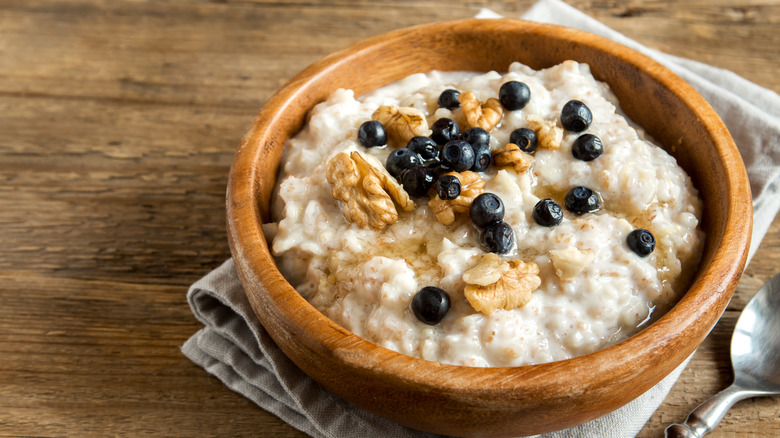What Happens To Your Blood Pressure When You Eat Oatmeal Every Day
Oatmeal can seem like such a boring breakfast food. Who wants oatmeal when you can have pancakes, French toast, or bacon? As dull as oatmeal can seem, it's one of the most healthy foods you can include in your diet.
A cup of oatmeal is just 166 calories with 4 grams of fiber to keep you full for a few hours. Because oatmeal has no added sugar, you can stay under the American Heart Association's limit for added sugar, which is no more than 6% of your daily calories. Oatmeal also has less than a gram of saturated fat to help manage your cholesterol (more on that later). You'll only find a trace of sodium in oatmeal, so you know eating oatmeal for breakfast won't cause high blood pressure. Oatmeal is considered a whole grain, and whole grains are a key food group recommended for the Dietary Approaches to Stop Hypertension (DASH) eating plan (per National Heart, Lung, and Blood Institute). Eating oats every day not only manages high blood pressure but also might help to lower it.
Oatmeal has unique nutrients that reduce blood pressure
Oatmeal might be a good source of iron, magnesium, zinc, and selenium, but other nutrients in oatmeal work together to lower blood pressure. According to a 2022 review in Nutrients, compounds called "avenanthramides" and "phenolic acids" boost nitric oxide in your blood vessels to improve blood flow. These compounds also reduce the inflammation and oxidative stress that can lead to high blood pressure. Substances in oatmeal also block enzymes that constrict your blood vessels. Your gut bacteria produce short-chain fatty acids when they process oats, and these fatty acids improve the function of your blood vessels.
Incorporating oatmeal into your eating plan can help reduce your blood pressure, particularly if you swap out refined grains. A 2023 review in the Journal of the Academy of Nutrition and Dietetics pooled the results of 21 studies involving the effect of oatmeal on high blood pressure. People who ate oatmeal lowered their systolic blood pressure (the top number) by an average of 2.82 mm Hg. If people had prehypertension before the start of the study, their diastolic blood pressure (the bottom number) went down after adding oatmeal to their diet.
Oatmeal has many more health benefits
People who have high cholesterol might have been told to eat more oatmeal. That's because the research reviewed in a 2023 article in Current Problems in Cardiology showed that oatmeal lowers total cholesterol, LDL cholesterol, and triglycerides. Oatmeal also improves your HDL cholesterol, which helps to clear cholesterol from your bloodstream. The beta-glucan in oatmeal forms a layer in your small intestine that prevents your body from absorbing cholesterol. Your body also removes bile acids after eating oatmeal, so your body uses the cholesterol in your system to make more bile acids. That means less cholesterol circulating in your blood.
This layer of beta-glucan also slows down the digestion of starch and glucose to control your blood sugar, according to a 2021 article in Foods. Steel-cut oatmeal is good for diabetes because it has a lower glycemic index (GI) compared to quick oats. The slower digestion of oatmeal also means you'll stay full for a little longer. This can help you eat less so you can lose weight. Oatmeal feeds your gut bacteria with its resistant starch, which produces butyrate. Butyrate not only improves your gut microbiome but also reduces inflammation, promotes sleep, and protects your brain.


